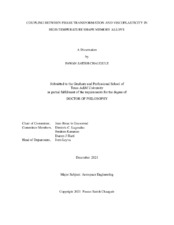| dc.contributor.advisor | le Graverend, Jean-Briac | |
| dc.creator | Chaugule, Pawan Satish | |
| dc.date.accessioned | 2022-07-27T16:44:17Z | |
| dc.date.available | 2023-12-01T09:22:20Z | |
| dc.date.created | 2021-12 | |
| dc.date.issued | 2021-12-06 | |
| dc.date.submitted | December 2021 | |
| dc.identifier.uri | https://hdl.handle.net/1969.1/196391 | |
| dc.description.abstract | The purpose of this research work is to further the understanding of the coupling between phase transformation and viscoplasticity in high-temperature shape memory alloys (HTSMAs), which are active materials. Fundamental understanding of the coupling is essential to facing the challenge of achieving improved actuation performance from HTSMAs. The improvement involves enhancing the alloy’s existing functional properties and work output to endure extremes in stress, strain and temperature. The improvement will eventually aid in moving closer to the overarching goal of reducing the weight of actuation systems required in the aerospace and automotive domains, while maintaining structural adaptability without critically affecting performance or the safety, in all to improve fuel efficiency. Experimental studies on these alloys have carved pathways for the above
improvement, and their processing with scalability has also been understood to prepare for an increasing demand in the future. But, for the successful design of these alloys, it is necessary to have a comprehensive understanding of the effect of viscoplasticity on their phase transformation or functional properties and the overall behavior.
The objective of the present study is to investigate the coupling between phase transformation and viscoplasticity in a Ti-rich Ni-Ti-20Hf (at.%) HTSMA. To achieve the objective two approaches are followed. Experimental investigations are conducted on the selected alloy at different thermal cycling rates to vary the amount of viscoplasticity generated, and observe its effect on the phase transformation and response. The results are analyzed and inferences are made based on the interactions between the above two phenomena. Parallelly, a crystal-plasticity model is developed which accounts for the phenomena observed experimentally and the coupling between the two phenomena. The model is calibrated using the experimental results and inferences, and the underlying mechanisms responsible for the coupled response, are brought forward.
The contributions of this study are: (i) new interpretations on the overall functional fatigue of Ni-Ti-Hf alloys; (ii) establishing rate-dependency of the entire macroscopic response and the active phenomena; (iii) revealing a two-way coupling between viscoplasticity and phase transformation; (iv) developing of a crystal-plasticity model for HTSMAs; and (v) generating anisotropic and isotropic coupled responses. | |
| dc.format.mimetype | application/pdf | |
| dc.language.iso | en | |
| dc.subject | High-Temperature Shape Memory Alloy (HTSMA) | |
| dc.subject | Ni-Ti-Hf | |
| dc.subject | Functional Fatigue | |
| dc.subject | Rate dependent | |
| dc.subject | ex-situ X-ray Diffraction | |
| dc.subject | Phase transformation | |
| dc.subject | Crystal Plasticity | |
| dc.subject | Viscoplastic material | |
| dc.title | Coupling between Phase Transformation and Viscoplasticity in High-Temperature Shape Memory Alloys | |
| dc.type | Thesis | |
| thesis.degree.department | Aerospace Engineering | |
| thesis.degree.discipline | Aerospace Engineering | |
| thesis.degree.grantor | Texas A&M University | |
| thesis.degree.name | Doctor of Philosophy | |
| thesis.degree.level | Doctoral | |
| dc.contributor.committeeMember | Lagoudas, Dimitris C | |
| dc.contributor.committeeMember | Karaman, Ibrahim | |
| dc.contributor.committeeMember | Hartl, Darren J | |
| dc.type.material | text | |
| dc.date.updated | 2022-07-27T16:44:18Z | |
| local.embargo.terms | 2023-12-01 | |
| local.etdauthor.orcid | 0000-0002-7570-6572 | |


